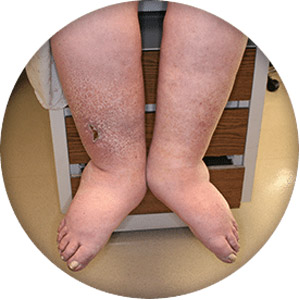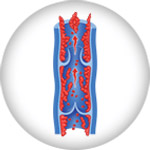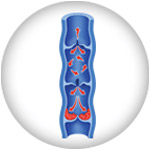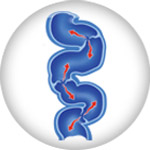Swelling/Edema

Symptom Details
When swelling is not a result of an injury it can be concerning. The symptom may be the result of many different conditions, but it may also signify an underlying venous condition such as deep venous disease (DVD), superficial venous insufficiency (SVI) and deep vein thrombosis (DVT). These venous problems lead to pooling of the blood in the legs or obstructed veins. Without proper blood flow in these areas, extra fluid can begin to build in the tissue. This pressure can cause puffiness in one leg or both, often restricting the range of motion in the ankles and feet. For some people, swelling can become so uncomfortable that the skin in the area becomes stretched and shiny.2 The skin can begin to seep and cause further breakdown. The progressive condition may start out with mild symptoms but with time, may lead to more moderate to severe symptoms.1,2,3
Mild
Moderate
Severe
Causes
Swelling in the feet and ankles can be the result of venous problems, including damaged valves that cause pooling of blood or obstructed veins that can’t transport enough blood back to the heart. When veins can’t function properly, fluid is forced out of the blood vessels into the surrounding tissue. Swelling in these areas may also be a result of obstructed lymphatic vessels, known as lymphedema. Fluid can begin to collect in these vessels and leak out into the tissue. There are also various conditions not related to PVD that may cause swelling. It is important to consult your doctor to determine the cause of swelling.
Risk Factors

Various conditions can lead to swelling, depending on underlying causes. Some people may carry a higher risk than others for developing the symptom. Risk factors include:3,4
What to Look For
If you are unsure of what to look for when determining if you have chronic or severe swelling, these are some helpful tips. It is important to consult your doctor to help determine a correct diagnosis.
Associated Symptoms
Varicose Veins
Varicose veins can become inflamed when the pooling of blood results in pressure on the vein walls resulting in redness, swelling, and a diffuse pain.
Skin Changes
The skin of the legs, ankles or feet may exhibit color changes, eczema, temperature changes, thickening of the skin and itching.
Tired, heavy legs
Bothersome leg discomfort may include pain, tiredness and heaviness due to increased venous pressure in the legs.
When to See a Doctor
When mild leg swelling persists or when you have moderate to severe swelling that does not go away, it is important to obtain a diagnosis right away. Take the step and talk to your doctor, or use our tool to locate a physician to get the help you need.
Associated PVD Diseases
Helpful Resources

PVD Doctor
Discussion Guide
Get helpful tips and advice on how to talk to your doctor about a PVD screening.

Patient Brochures
Third-Party Resources
Helpful Websites
Blogs
Apps
A mobile app built by cardiologists, to simplify understanding of most cardiac and peripheral vascular conditions and treatments.
Find a Doctor
Consult your doctor to learn more about PVD and how to maintain your health. You can also use our Doctor Finder tool below to find a specialist near you.
This tool is not inclusive of all specialists. Consult with your insurance provider to find specialists that are covered within your network.
Are You a Healthcare Professional?
Find out how to register your practice with us.
1. “Leg swelling Causes.” Mayo Clinic. Mayo Foundation for Medical Education and Research, 01 Apr. 2017. 2. “Causes and signs of edema.” PubMed. U.S. National Library of Medicine. December 30, 2016 3. Trayes et al. “Edema: Diagnosis and Management.” Am Fam Physician. 2013 Jul 15;88(2):102-110. 4. “Edema.” Medline PLUS. U.S. National Library of Medicine.
Disclaimer
The opinions and clinical experiences presented herein are for informational purposes only. Individual results may vary depending on a variety of patient-specific attributes and related factors. Dr. Raghu Kolluri has been compensated by Philips for his services in preparing and providing this material for Philips further use and distribution. We offer links to third-party websites that may be of interest to our website visitors and in no way, represent any affiliation or endorsement of the information provided on those linked websites. These links are provided solely for your convenience and to assist you in learning more information on this topic. However, Philips does not control, endorse or guarantee the accuracy of the information contained on the linked sites. In addition, Philips makes no representations or warranties of any kind with regards to any third-party websites or information contained therein. If you have any questions or concerns about the information on the linked third-party websites, please contact the third-party websites directly.





